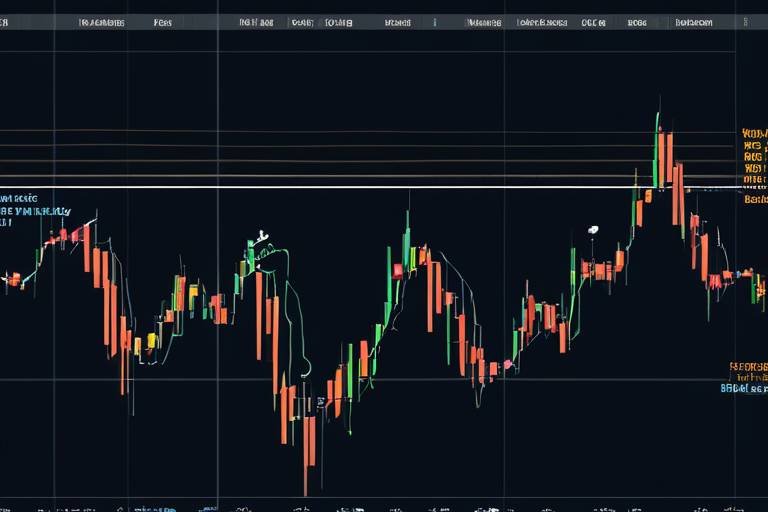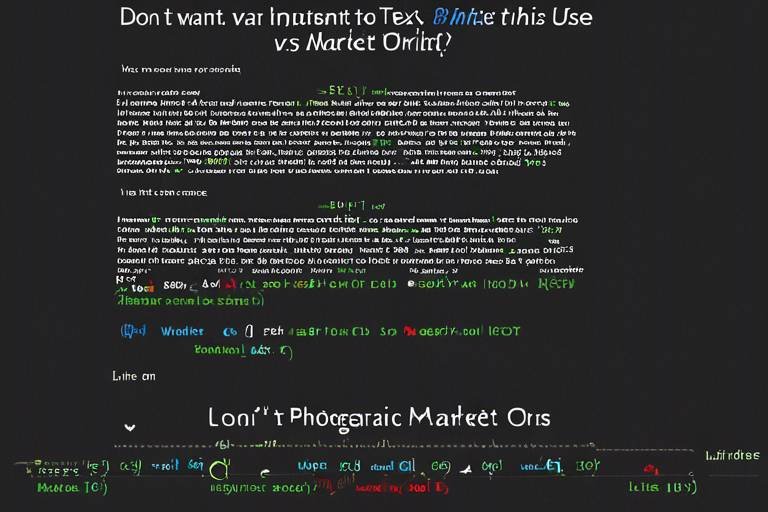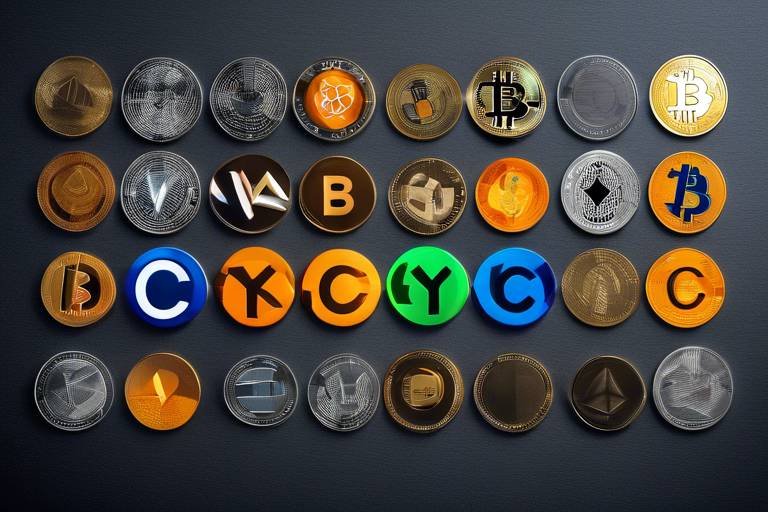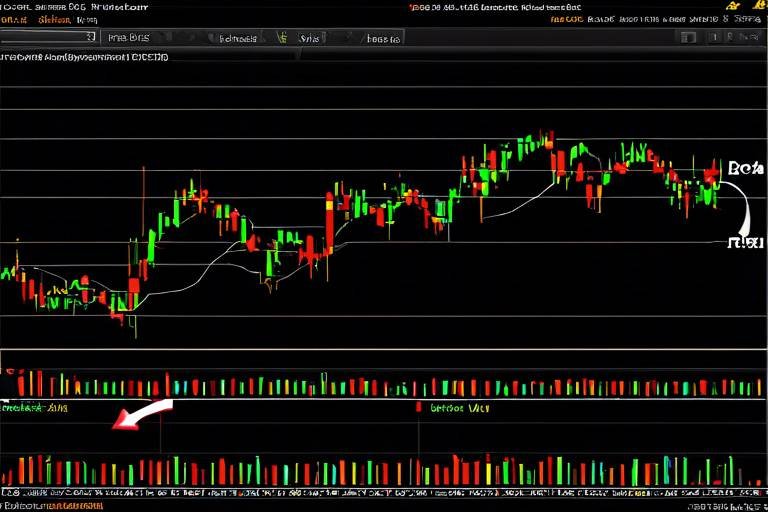Using Elliot Wave Theory for Crypto Trading Analysis
In the ever-evolving world of cryptocurrency trading, finding reliable methods to analyze market movements is crucial for success. One such method that has gained traction among traders is the Elliot Wave Theory. This theory offers a structured approach to understanding price movements by identifying patterns that repeat over time. With the crypto market's notorious volatility, applying Elliot Wave Theory can be a game-changer for traders looking to enhance their analysis and make informed decisions.
The beauty of Elliot Wave Theory lies in its ability to break down complex market behaviors into manageable wave patterns. It operates on the premise that market prices move in waves, which can be categorized into two main types: impulse waves and corrective waves. By mastering these waves, traders can better predict potential price movements and identify optimal entry and exit points. Imagine riding a wave at the beach; if you can anticipate the rise and fall of the water, you can surf effectively. The same principle applies to trading when using Elliot Wave Theory.
But why should you care about this theory? Well, for starters, it provides a framework for understanding the market's psychology. Each wave reflects the collective sentiment of traders, whether they are feeling bullish or bearish. By analyzing these sentiments through wave patterns, traders can gain insights into where the market might be headed next. This is particularly valuable in the cryptocurrency space, where emotions often drive price action more than fundamentals.
Moreover, Elliot Wave Theory encourages a disciplined approach to trading. It helps traders set clear goals and strategies based on the identified wave patterns, reducing the likelihood of impulsive decisions driven by fear or greed. By adhering to a structured methodology, traders can enhance their overall profitability and manage risks more effectively.
| Wave Type | Description | Characteristics |
|---|---|---|
| Impulse Waves | Strong movements in the direction of the trend | Composed of five waves, indicating a bullish market |
| Corrective Waves | Movements against the prevailing trend | Usually consist of three waves, signaling potential reversals |
As you delve deeper into applying Elliot Wave Theory to your trading strategies, it's essential to remain aware of its limitations. While it can significantly enhance market predictions, the subjective nature of wave counting can lead to varying interpretations among traders. Additionally, the high volatility and noise inherent in cryptocurrency markets can complicate the application of this theory. Thus, combining Elliot Wave analysis with other technical indicators can provide a more comprehensive view of market conditions.
In summary, Elliot Wave Theory is not just a theoretical concept; it’s a practical tool that can empower traders to navigate the complexities of cryptocurrency trading. By understanding its principles and applying them effectively, you can enhance your market analysis, improve your trading strategies, and ultimately achieve better results in this exciting yet unpredictable market.
- What is Elliot Wave Theory?
Elliot Wave Theory is a technical analysis tool that identifies market trends through wave patterns, helping traders predict future price movements.
- How can I apply Elliot Wave Theory to crypto trading?
By recognizing wave patterns and understanding their implications, traders can make informed decisions regarding entry and exit points in the market.
- What are the main types of waves in Elliot Wave Theory?
Impulse waves, which move in the direction of the trend, and corrective waves, which go against it, are the two primary types of waves.
- What are the benefits of using Elliot Wave Theory?
This theory can lead to enhanced market predictions, improved risk management, and a more structured approach to trading.
- Are there any limitations to Elliot Wave Theory?
Yes, the subjective nature of wave counting and the volatility of cryptocurrency markets can pose challenges when applying this theory.

Understanding Elliot Wave Theory
Elliot Wave Theory is more than just a technical analysis tool; it's a fascinating framework that helps traders decode the often chaotic movements of financial markets, especially in the realm of cryptocurrencies. At its core, this theory posits that market trends unfold in specific patterns that can be identified and predicted. Imagine the market as a vast ocean, with waves rising and falling in a rhythmic dance. By understanding the underlying wave patterns, traders can ride these waves to maximize their profits.
The foundation of Elliot Wave Theory is built upon the idea that market movements are not random but follow a predictable structure. This structure consists of two primary types of waves: impulse waves and corrective waves. Impulse waves move in the direction of the trend, while corrective waves move against it. Just like a surfer knows when to paddle out and when to ride the wave back to shore, traders can use these insights to make informed decisions about when to enter or exit a position.
To grasp the essence of Elliot Wave Theory, it's essential to familiarize yourself with its key components:
- Wave Degrees: Waves can occur at different scales, from micro to macro levels. Each wave can be analyzed within the context of larger and smaller waves, creating a multi-layered understanding of market dynamics.
- Wave Patterns: The theory outlines specific patterns that waves tend to follow, allowing traders to anticipate future movements based on historical data.
- Market Psychology: Elliot Wave Theory is based on the collective psychology of market participants. Understanding how emotions influence trading decisions can provide valuable insights into market trends.
By applying these principles, traders can enhance their market analysis, giving them a competitive edge in the fast-paced world of cryptocurrency trading. Understanding Elliot Wave Theory is not just about recognizing patterns; it's about developing a mindset that anticipates market shifts and reacts accordingly. So, whether you're a seasoned trader or just starting, diving into the depths of Elliot Wave Theory can empower you to navigate the turbulent waters of the crypto market with confidence.

Key Principles of Elliot Wave Theory
The Elliot Wave Theory is built upon a few foundational principles that help traders decode the complex movements of the market. Understanding these principles is not just beneficial; it’s essential for anyone looking to leverage this theory in their trading strategy. At its core, the theory posits that market movements are not random but rather follow a predictable pattern based on human psychology and collective behavior. This insight can be a game-changer for crypto traders aiming to make informed decisions.
One of the key aspects of Elliot Wave Theory is the concept of wave structure. The market moves in waves, and these waves can be categorized into two main types: impulse waves and corrective waves. Impulse waves are the strong moves that align with the prevailing trend, while corrective waves are the counter movements that go against the trend. This duality is crucial for traders as it helps them identify the overall market direction and potential reversal points.
To illustrate this, let’s break down the wave structure:
| Wave Type | Description | Number of Waves |
|---|---|---|
| Impulse Waves | Moves in the direction of the trend | 5 |
| Corrective Waves | Moves against the trend | 3 |
Another fundamental principle of this theory is the Fibonacci ratio, which plays a significant role in determining potential price targets and retracement levels. The Fibonacci sequence is a mathematical concept that appears frequently in nature, and it also has a profound presence in financial markets. Traders often use Fibonacci retracement levels to identify potential support and resistance zones during corrective waves. This allows them to make more educated predictions about where the price might reverse or continue its movement.
Moreover, the time factor is equally important in Elliot Wave Theory. Waves not only have a specific structure but also a timeline. Each wave takes a certain amount of time to complete, and understanding this can help traders anticipate future price movements more accurately. For instance, if a trader notices that an impulse wave is taking longer than usual to complete, it may indicate a weakening trend and the potential for a reversal.
In summary, the key principles of Elliot Wave Theory revolve around recognizing the wave structures, applying Fibonacci ratios, and considering the time factor. By mastering these concepts, traders can significantly enhance their market analysis, making it easier to spot opportunities and manage risks effectively.
- What is the main purpose of Elliot Wave Theory?
The main purpose is to provide a framework for analyzing market trends and predicting future price movements based on wave patterns. - Can Elliot Wave Theory be applied to all cryptocurrencies?
Yes, while it is most commonly used in stocks and forex, the principles of Elliot Wave Theory can be applied to any financial market, including cryptocurrencies. - How can I improve my wave counting skills?
Practice is key! Start by analyzing historical price charts and try to identify wave patterns. There are also various resources and communities that can help you learn.

Wave Structure and Patterns
The Elliot Wave Theory is fascinating, primarily because it encapsulates the rhythm of market movements in a series of waves. Understanding the wave structure and patterns is essential for traders who want to harness this theory effectively in their cryptocurrency trading strategies. At its core, the wave structure is divided into two main categories: impulse waves and corrective waves. Each of these categories has its own unique characteristics and plays a crucial role in predicting market behavior.
Impulse waves are the driving force behind market trends. Typically, they consist of five distinct waves that move in the direction of the prevailing trend. These waves can often be identified by their strong momentum and clear direction. For instance, during a bullish market, the impulse waves will rise sharply, creating a series of higher highs and higher lows. Recognizing these patterns allows traders to pinpoint optimal entry points for their trades. Conversely, corrective waves consist of three waves that move against the prevailing trend. These waves often serve as a pause or a pullback in the market, offering traders valuable insights into potential reversals or corrections.
To illustrate the relationship between impulse and corrective waves, consider the following table:
| Wave Type | Number of Waves | Direction | Characteristics |
|---|---|---|---|
| Impulse Waves | 5 | In the direction of the trend | Strong momentum, clear direction |
| Corrective Waves | 3 | Against the direction of the trend | Indicates potential reversals, weaker momentum |
Understanding these wave structures is not just about recognizing patterns; it's about interpreting the underlying psychology of the market participants. Each wave reflects the collective sentiment of traders, influenced by factors such as news events, market trends, and investor behavior. For example, during an impulse wave, the market is typically driven by optimism, where traders are eager to buy, leading to a rapid price increase. On the other hand, corrective waves often emerge from a sense of uncertainty or profit-taking, where traders decide to sell, resulting in a temporary price decline.
Moreover, the interplay between these waves can create various patterns, such as zigzags, flats, and triangles, each signifying different market conditions. Recognizing these patterns can significantly enhance a trader's ability to forecast future price movements. For instance, a zigzag pattern, characterized by its sharp price movements, may indicate a strong corrective phase, while a triangle pattern often signals a period of consolidation before a breakout.
In summary, mastering the wave structure and patterns of the Elliot Wave Theory can provide traders with a powerful toolkit for analyzing market movements. By understanding how impulse and corrective waves interact, traders can make more informed decisions, ultimately enhancing their trading strategies in the ever-evolving cryptocurrency landscape.
- What is the Elliot Wave Theory? It is a technical analysis tool that uses wave patterns to predict market trends.
- How do impulse and corrective waves differ? Impulse waves move in the direction of the trend and consist of five waves, while corrective waves move against the trend and consist of three waves.
- Can Elliot Wave Theory be applied to cryptocurrencies? Yes, it can be effectively used to analyze price movements in cryptocurrencies.
- What are some common challenges of using this theory? Subjectivity in wave counting and market volatility can complicate its application.

Impulse Waves Explained
Impulse waves are the powerhouse of the Elliot Wave Theory, representing strong moves in the direction of the prevailing trend. Typically, these waves consist of five distinct segments, each contributing to the overall momentum of the market. Imagine riding a wave at the beach—the rush of water propelling you forward is akin to the force of impulse waves driving prices up in a bullish market.
To visualize this, consider the following structure of an impulse wave:
| Wave Number | Description |
|---|---|
| Wave 1 | Initial movement upward, often driven by early investors or news. |
| Wave 2 | Correction phase where prices pull back, typically not exceeding the start of Wave 1. |
| Wave 3 | The strongest and longest wave, characterized by widespread investor enthusiasm. |
| Wave 4 | Another corrective phase, but usually shallower than Wave 2, indicating a healthy trend. |
| Wave 5 | The final push, often driven by euphoria, leading to a peak before a significant correction. |
Understanding these waves can significantly enhance a trader's ability to identify optimal entry points. For instance, savvy traders often look for opportunities to enter during the corrective phases (Waves 2 and 4) as they present lower-risk scenarios compared to entering during the euphoric push of Wave 5. This strategy allows traders to capitalize on the momentum of the subsequent impulse wave, maximizing their potential profit.
However, it's essential to remember that not all impulse waves are created equal. Market conditions can vary greatly, and the strength of each wave can be influenced by external factors such as news events, market sentiment, and overall economic conditions. As a trader, staying informed and adaptable is key to successfully navigating these waves.
In conclusion, impulse waves are a fundamental concept in Elliot Wave Theory that can provide valuable insights into market trends. By recognizing the structure and phases of these waves, traders can make more informed decisions, ultimately enhancing their trading strategies and increasing their chances of success in the fast-paced world of cryptocurrency.
- What are impulse waves? Impulse waves are strong price movements in the direction of the trend, typically consisting of five segments.
- How can I identify impulse waves? Look for a clear five-wave structure where the third wave is usually the longest and strongest.
- Can impulse waves predict market reversals? Impulse waves indicate the strength of a trend, but they do not guarantee a reversal. Always combine with other analysis tools.
- What should I do during corrective phases? Corrective phases often present good entry points for traders looking to capitalize on the next impulse wave.

Corrective Waves Explained
Corrective waves are a fascinating aspect of the Elliot Wave Theory, representing the market's tendency to pull back against the prevailing trend. Unlike impulse waves, which surge forward, corrective waves move in the opposite direction and typically consist of three distinct waves. This structure can be likened to a rubber band being stretched; when the tension is released, it snaps back, often leading to a price correction in the crypto market.
Understanding corrective waves is crucial for traders who want to anticipate potential reversals and capitalize on price movements. These waves can manifest in various forms, including zigzags, flats, and triangles, each providing unique insights into market behavior. For instance, a zigzag corrective wave typically consists of a sharp decline followed by a more subdued recovery, while a flat wave may indicate a period of consolidation before the market resumes its trend.
To effectively identify and analyze corrective waves, traders often look for specific characteristics:
- Wave A: This is the initial move against the trend, indicating the start of a correction.
- Wave B: A partial retracement of Wave A, suggesting a brief rally before the market resumes its downward trajectory.
- Wave C: This wave typically extends beyond the low of Wave A, completing the corrective pattern.
By recognizing these waves, traders can better position themselves in the market. For example, if a trader identifies a corrective wave forming after a significant price increase, they might consider it an opportunity to enter a short position, anticipating a further decline. Conversely, if they spot a corrective wave following a downturn, it could signal a potential buying opportunity as the market prepares to rally again.
However, it's important to note that while corrective waves can offer valuable insights, they are not foolproof indicators. The cryptocurrency market is notoriously volatile, and external factors can influence price movements, making it essential for traders to use corrective wave analysis in conjunction with other technical tools and indicators. This holistic approach can enhance decision-making and improve overall trading performance.
Q: What are corrective waves in the context of Elliot Wave Theory?
A: Corrective waves are price movements that go against the prevailing trend, typically forming a three-wave structure. They provide insights into potential market reversals and corrections.
Q: How can I identify corrective waves in cryptocurrency trading?
A: Traders can identify corrective waves by looking for specific patterns such as zigzags, flats, and triangles, and analyzing the characteristics of each wave within the corrective structure.
Q: Are corrective waves reliable indicators for trading decisions?
A: While corrective waves can provide valuable insights, they should not be relied upon in isolation. Combining wave analysis with other technical indicators can lead to more informed trading decisions.
Q: Can external factors affect the accuracy of corrective wave analysis?
A: Yes, the cryptocurrency market is influenced by various external factors such as news events, regulatory changes, and market sentiment, which can impact price movements and the effectiveness of wave analysis.

Application in Cryptocurrency Trading
When it comes to cryptocurrency trading, applying Elliot Wave Theory can be a game-changer for traders looking to enhance their market analysis. Imagine navigating through the tumultuous waters of the crypto market with a reliable compass; that's what Elliot Wave Theory provides. By recognizing the distinct wave patterns, traders can make informed decisions that significantly improve their chances of success.
To effectively apply this theory, one must first become adept at identifying the various wave formations that emerge in the price charts of cryptocurrencies. The process involves not just a superficial glance at the charts but a deep dive into the nuances of wave structures. For instance, when traders spot an impulse wave, they can anticipate a strong price movement in the prevailing trend's direction. This is crucial for determining optimal entry points, especially in a bullish market where timing can mean the difference between profit and loss.
On the other hand, recognizing corrective waves is equally important. These waves often signal potential reversals, providing traders with critical insights into when to exit a position or adjust their strategies. By analyzing these corrective patterns, traders can better prepare for market fluctuations, which are commonplace in the volatile world of cryptocurrencies.
Moreover, the application of Elliot Wave Theory isn't just about recognizing patterns; it also involves a strategic approach to risk management. By using wave analysis, traders can set appropriate stop-loss levels based on anticipated market movements. This proactive measure not only protects capital but also fosters a disciplined trading practice, which is essential in maintaining long-term profitability.
To illustrate the practical application of Elliot Wave Theory, let's consider a hypothetical scenario:
| Wave Type | Description | Trading Action |
|---|---|---|
| Impulse Wave | Strong movement in the direction of the trend. | Consider entering a long position. |
| Corrective Wave | Movement against the prevailing trend. | Evaluate exiting a position or placing a stop-loss. |
| Market Reversal | Potential change in market direction. | Reassess trading strategy and manage risk. |
In conclusion, the application of Elliot Wave Theory in cryptocurrency trading is not just about theory but about developing a keen sense of market behavior. By understanding and identifying wave patterns, traders can make informed decisions that enhance their trading strategies and improve their overall performance in the crypto market.
- What is Elliot Wave Theory?
Elliot Wave Theory is a technical analysis tool that identifies market trends through wave patterns, helping traders predict future price movements.
- How can I apply Elliot Wave Theory in crypto trading?
By recognizing wave structures and patterns, you can make informed trading decisions and manage risks more effectively.
- What are the main types of waves in Elliot Wave Theory?
The main types of waves are impulse waves, which move in the direction of the trend, and corrective waves, which move against it.
- Are there any limitations to Elliot Wave Theory?
Yes, the subjectivity in wave counting and the volatility of cryptocurrency markets can pose challenges in accurately applying the theory.

Benefits of Using Elliot Wave Theory
This article explores the application of Elliot Wave Theory in cryptocurrency trading, detailing its principles, benefits, and practical strategies for traders aiming to enhance their market analysis.
Elliot Wave Theory is a technical analysis tool that identifies market trends through wave patterns. Understanding its foundational concepts is crucial for effectively applying it to crypto trading strategies.
The theory is based on specific principles that dictate how waves form and interact. Familiarizing yourself with these principles can help traders forecast market movements more accurately.
Elliot Wave Theory consists of various wave structures, including impulse and corrective waves. Recognizing these patterns is essential for predicting potential price movements in cryptocurrencies.
Impulse waves are strong moves in the direction of the trend, typically consisting of five waves. Understanding these can help traders identify entry points in a bullish market.
Corrective waves move against the prevailing trend and usually consist of three waves. Analyzing these can provide insights into potential market reversals and corrections.
Applying Elliot Wave Theory to cryptocurrency trading involves recognizing wave patterns and making informed decisions based on market analysis. This approach can enhance trading strategies and risk management.
Utilizing Elliot Wave Theory offers various benefits that can significantly improve a trader's performance in the cryptocurrency market. One of the most notable advantages is the enhanced market predictions. By analyzing wave patterns, traders can make informed predictions about future price movements, allowing for timely entry and exit strategies. This is particularly crucial in the volatile crypto market, where prices can swing dramatically in short periods. The ability to anticipate these movements can mean the difference between profit and loss.
Another important benefit is the structured approach to trading that Elliot Wave Theory provides. This structure helps traders develop a clear and systematic method for analyzing market trends, which can lead to improved risk management. For instance, by recognizing potential wave patterns, traders can identify where to set their stop-loss levels more effectively. This disciplined approach not only helps in protecting capital but also fosters a more confident trading mindset.
Moreover, the theory encourages traders to adopt a long-term perspective. Instead of making impulsive decisions based on short-term price fluctuations, Elliot Wave Theory promotes a deeper understanding of market cycles. This allows traders to ride the waves of the market rather than get tossed around by them.
To summarize, the benefits of using Elliot Wave Theory in crypto trading can be categorized as follows:
- Improved Market Predictions: Accurate forecasting of price movements.
- Better Risk Management: Identifying potential reversals and setting stop-loss levels.
- Structured Trading Approach: Fostering a disciplined mindset and systematic analysis.
- Long-Term Perspective: Encouraging traders to focus on market cycles.
Incorporating these benefits into your trading strategy can lead to a more informed and confident trading experience, ultimately enhancing your profitability in the ever-evolving world of cryptocurrency.
While Elliot Wave Theory is a powerful tool, it comes with challenges and limitations. Understanding these can help traders navigate its complexities and avoid common pitfalls in crypto trading.
One of the main challenges of Elliot Wave Theory is the subjective nature of wave counting, which can lead to different interpretations and potential trading errors.
The high volatility and noise in cryptocurrency markets can complicate the application of Elliot Wave Theory, making it essential for traders to combine it with other analytical tools for better accuracy.
1. What is Elliot Wave Theory?
Elliot Wave Theory is a technical analysis tool that identifies market trends through wave patterns, helping traders predict future price movements.
2. How can Elliot Wave Theory improve my trading?
By using this theory, traders can enhance their market predictions, improve risk management, and adopt a structured approach to trading.
3. Is Elliot Wave Theory suitable for cryptocurrency trading?
Yes, it can be effectively applied to cryptocurrency trading, although traders should be aware of the unique challenges posed by market volatility.
4. What are the main challenges of using Elliot Wave Theory?
The main challenges include the subjectivity in wave counting and the high volatility in cryptocurrency markets, which can complicate analysis.

Enhanced Market Predictions
One of the standout benefits of using Elliot Wave Theory in cryptocurrency trading is its ability to enhance market predictions significantly. This theory allows traders to delve deep into the intricate patterns of price movements, enabling them to make more informed decisions. Imagine trying to navigate through a dense forest without a map; you might wander aimlessly. Now, picture having a detailed map that outlines the trails, obstacles, and landmarks. That's essentially what Elliot Wave Theory provides for traders in the chaotic world of crypto.
By recognizing the distinct wave patterns—both impulsive and corrective—traders can anticipate potential price movements with greater accuracy. For instance, when an impulse wave is identified, it often indicates a strong trend in a particular direction. This insight can prompt traders to enter the market at optimal times, maximizing their potential for profit. On the flip side, when a corrective wave appears, it signals a potential reversal, allowing traders to adjust their strategies accordingly.
Moreover, the ability to predict market movements aligns perfectly with the volatile nature of cryptocurrencies. The market can swing dramatically within short timeframes, and having a reliable predictive tool like Elliot Wave Theory can mean the difference between capitalizing on a trend or suffering significant losses. For example, a trader who accurately identifies the end of a corrective wave might decide to enter a position just as the market begins its next impulse wave, positioning themselves for a profitable ride.
To illustrate the power of enhanced market predictions through Elliot Wave Theory, consider the following table that outlines a hypothetical trading scenario:
| Wave Type | Market Action | Trader's Strategy |
|---|---|---|
| Impulse Wave | Strong upward movement | Enter long position |
| Corrective Wave | Market retracement | Consider exiting or hedging |
| Impulse Wave | Continuation of upward trend | Add to long position |
This table illustrates how traders can adapt their strategies based on the identified wave patterns. By understanding and applying these principles, traders not only improve their chances of success but also cultivate a more disciplined approach to trading.
In conclusion, the enhanced market predictions facilitated by Elliot Wave Theory empower traders to navigate the unpredictable waters of cryptocurrency trading with confidence. By leveraging these insights, they can make timely decisions that align with market trends, ultimately enhancing their profitability and reducing the emotional strain that often accompanies trading in such a volatile environment.
- What is Elliot Wave Theory?
Elliot Wave Theory is a technical analysis tool that identifies market trends through wave patterns, helping traders predict future price movements.
- How does Elliot Wave Theory enhance market predictions?
By recognizing wave patterns, traders can make informed predictions about future price movements, allowing for timely entry and exit strategies.
- Can Elliot Wave Theory be used for all cryptocurrencies?
Yes, while it is particularly effective in volatile markets like cryptocurrencies, it can be applied to various assets.
- What are the limitations of Elliot Wave Theory?
The subjectivity in wave counting and high market volatility can complicate its application, necessitating the use of additional analytical tools.

Risk Management Strategies
When it comes to trading cryptocurrencies, having a solid risk management strategy is not just a good idea—it's essential. The volatile nature of the crypto market can lead to significant gains, but it can just as easily result in steep losses. Therefore, incorporating Elliot Wave Theory into your risk management practices can provide a structured framework to safeguard your investments.
One of the key aspects of risk management is identifying potential market reversals. By analyzing wave patterns, traders can spot signs that a trend may be changing direction. For example, if you observe a corrective wave formation after a strong impulse wave, it might be time to consider adjusting your positions. This proactive approach can help mitigate losses before they escalate.
Setting appropriate stop-loss levels is another critical component of effective risk management. A stop-loss order is a predetermined price point at which you will exit a trade to prevent further losses. By placing your stop-loss just below a significant support level identified through Elliot Wave analysis, you can protect your capital while allowing for potential price fluctuations. This way, you can ride the waves without being wiped out by unexpected downturns.
Additionally, it’s vital to maintain a well-diversified portfolio. In the world of crypto, diversification can help spread risk across different assets, reducing the impact of a poor-performing investment. You might consider allocating your capital based on the wave structures you identify. For instance:
| Asset | Wave Structure | Allocation Percentage |
|---|---|---|
| Bitcoin | Impulse Wave | 40% |
| Ethereum | Corrective Wave | 30% |
| Altcoin A | Impulse Wave | 20% |
| Altcoin B | Corrective Wave | 10% |
This table illustrates how you might allocate your investments based on the analysis of wave structures. By diversifying your investments, you can reduce the overall risk while still participating in the potential upside of various cryptocurrencies.
Finally, it's crucial to adopt a disciplined trading mindset. Emotional trading can lead to impulsive decisions that deviate from your established strategies. By sticking to your risk management plan and using Elliot Wave Theory as a guide, you can navigate the turbulent waters of cryptocurrency trading with greater confidence.
Q1: What is the best way to start using Elliot Wave Theory for risk management?
A1: Begin by familiarizing yourself with the basic wave structures and practice identifying them on price charts. Use this knowledge to set stop-loss levels and assess potential market reversals.
Q2: How can I improve my wave counting accuracy?
A2: Regular practice and studying historical charts can enhance your wave counting skills. Additionally, consider using software tools that assist in wave analysis to reduce subjectivity.
Q3: Is it necessary to combine Elliot Wave Theory with other tools?
A3: Yes, while Elliot Wave Theory is powerful, combining it with other technical analysis tools can provide a more comprehensive view of the market and improve your trading decisions.

Challenges and Limitations
While Elliot Wave Theory is a powerful tool for analyzing market trends, it is not without its challenges and limitations. Understanding these hurdles can significantly enhance a trader's ability to navigate the complexities of the cryptocurrency market. One major challenge is the inherent subjectivity in wave counting. Different traders may interpret wave patterns differently, leading to conflicting conclusions about market direction. This subjectivity can result in potential trading errors if traders rely solely on their interpretations without confirming them with additional analysis.
Moreover, the high volatility of cryptocurrency markets adds another layer of complexity. Prices can fluctuate wildly in a short period, making it challenging to apply Elliot Wave Theory consistently. For instance, a trader might identify an impulse wave, only to see rapid price movements that invalidate their analysis moments later. This market noise can obscure clear wave patterns, making it crucial for traders to combine Elliot Wave Theory with other analytical tools, such as moving averages or relative strength index (RSI), to improve accuracy.
Another limitation is the timeframe dependency of wave patterns. Elliot Wave Theory can yield different results depending on whether the trader is analyzing short-term or long-term charts. For instance, a wave that appears to be a corrective wave on a daily chart might look like an impulse wave on a 15-minute chart. This discrepancy can lead to confusion and misinterpretation of market signals, especially for novice traders who may not have a firm grasp of how to adjust their analysis based on different timeframes.
Lastly, while the theory provides a structured approach to trading, it does not guarantee success. The cryptocurrency market is influenced by numerous external factors, including regulatory changes, market sentiment, and technological advancements, which can all impact price movements. Therefore, a comprehensive trading strategy should incorporate a variety of tools and methods, rather than relying solely on Elliot Wave Theory.
- What is Elliot Wave Theory?
It is a technical analysis tool that identifies market trends through wave patterns, helping traders forecast future price movements. - How can I improve my wave counting accuracy?
Practice is key! Additionally, using multiple timeframes and confirming patterns with other indicators can enhance accuracy. - Is Elliot Wave Theory suitable for all trading styles?
While it can be beneficial for many, traders should ensure it aligns with their individual strategies and risk tolerance. - What should I do if I find conflicting wave patterns?
Consider integrating other analysis methods and indicators to validate your findings before making trading decisions.

Subjectivity in Wave Counting
The beauty of Elliot Wave Theory lies in its ability to provide traders with a framework for understanding market movements. However, one of the significant challenges that traders face is the . This subjectivity can lead to various interpretations of the same market data, which can ultimately affect trading decisions. Imagine trying to decipher a complex piece of art; each viewer might see something different based on their perspective and experiences. Similarly, when it comes to wave counting, two traders might analyze the same price chart and come up with completely different wave structures.
At its core, wave counting requires a keen eye for detail and a solid understanding of the underlying principles of the theory. Traders must identify the start and end of each wave, and this process can be influenced by personal biases and interpretations. For instance, one trader might see a particular section of the chart as part of an impulse wave, while another might classify it as a corrective wave. This discrepancy can lead to differing predictions about future price movements, making it crucial for traders to be aware of their own biases.
To illustrate this point, consider the following table that highlights some common pitfalls in wave counting:
| Common Pitfalls | Description |
|---|---|
| Overlooking Minor Waves | Many traders focus only on major waves and ignore smaller, yet significant, waves that can influence overall market trends. |
| Confirmation Bias | Traders may favor a wave count that aligns with their existing beliefs, leading to skewed interpretations. |
| Ignoring Market Context | Without considering broader market conditions, wave counts can become misleading, as they may not account for external factors affecting price movements. |
It's essential to approach wave counting with a degree of flexibility. Just like a skilled musician can improvise based on the mood of the audience, traders should be open to adjusting their wave counts as new information becomes available. This adaptability can help mitigate the risks associated with the subjectivity of wave counting. Moreover, combining Elliot Wave Theory with other technical analysis tools, such as moving averages or relative strength index (RSI), can provide a more rounded perspective, helping to validate wave counts and enhance overall trading strategies.
In conclusion, while the subjectivity in wave counting can present challenges, it also offers an opportunity for traders to develop their analytical skills. By remaining aware of their biases, staying flexible in their approach, and integrating other analytical methods, traders can navigate the complexities of Elliot Wave Theory more effectively. Remember, the path to successful trading is often paved with learning from both successes and mistakes.

Market Volatility and Noise
When diving into the world of cryptocurrency trading, one of the most significant hurdles traders face is the high volatility and inherent noise of the market. Unlike traditional assets, cryptocurrencies can experience dramatic price swings within a matter of hours, or even minutes. This volatility can be both a blessing and a curse. On one hand, it presents lucrative trading opportunities; on the other, it can lead to unexpected losses if not managed properly.
The unpredictable nature of crypto markets means that traders must remain vigilant and adaptable. You might find yourself staring at a price chart, only to watch the value of your asset plummet or soar in an instant. This rapid fluctuation can create a cacophony of market noise, making it challenging to discern genuine trends from mere blips on the radar. As you navigate this chaotic environment, it’s essential to understand how to filter out the noise and focus on the signals that matter.
To tackle the challenges posed by market volatility and noise, traders often employ a combination of strategies. Here are a few key approaches:
- Combining Analytical Tools: Relying solely on Elliot Wave Theory may not be enough. Integrating other technical indicators like moving averages, RSI (Relative Strength Index), or MACD (Moving Average Convergence Divergence) can provide a more comprehensive view of the market.
- Setting Clear Trading Rules: Establishing specific entry and exit points based on your analysis can help you avoid emotional trading decisions that often lead to losses.
- Utilizing Stop-Loss Orders: Implementing stop-loss orders can protect your investments from significant downturns, allowing you to manage risk effectively.
Moreover, it's crucial to stay updated with market news and events that could influence price movements. Major announcements, regulatory changes, or technological advancements can all contribute to sudden market shifts. By keeping an ear to the ground, you can better prepare for potential volatility and adjust your strategies accordingly.
Ultimately, while the noise of the crypto market can be overwhelming, understanding its dynamics and employing a disciplined approach can help you navigate through the chaos. Embrace the volatility as part of the game, but always remember to stay grounded in your analysis and strategies.
- What is market volatility? Market volatility refers to the rate at which the price of an asset increases or decreases for a given set of returns. In the context of cryptocurrencies, it often means rapid price changes.
- How can I manage risk in a volatile market? Using stop-loss orders, diversifying your portfolio, and setting clear trading rules can help manage risk effectively.
- Is it possible to predict market movements accurately? While tools like Elliot Wave Theory can help identify patterns, no method guarantees accurate predictions due to the unpredictable nature of the market.
Frequently Asked Questions
- What is Elliot Wave Theory?
Elliot Wave Theory is a technical analysis method that identifies market trends through specific wave patterns. It helps traders analyze price movements and forecast future market behavior in various trading environments, including cryptocurrencies.
- How can I apply Elliot Wave Theory to crypto trading?
To apply Elliot Wave Theory in crypto trading, you need to recognize wave patterns such as impulse and corrective waves. By understanding these patterns, you can make informed trading decisions, enhancing your strategies and potentially increasing profitability.
- What are impulse and corrective waves?
Impulse waves are strong movements that follow the direction of the prevailing trend, usually consisting of five sub-waves. In contrast, corrective waves move against the trend and typically consist of three sub-waves. Recognizing these waves can help you identify entry and exit points in the market.
- What are the benefits of using Elliot Wave Theory?
Using Elliot Wave Theory can improve market predictions, enhance risk management strategies, and provide a structured approach to trading. This can lead to better decision-making and increased profitability in the highly volatile cryptocurrency market.
- What challenges should I be aware of when using Elliot Wave Theory?
One major challenge is the subjective nature of wave counting, which can lead to different interpretations and potential trading errors. Additionally, the high volatility and noise in cryptocurrency markets can complicate the application of the theory, making it essential to combine it with other analytical tools.
- Can Elliot Wave Theory guarantee profits in crypto trading?
No trading strategy, including Elliot Wave Theory, can guarantee profits. While it can enhance your market analysis and decision-making, it is important to remember that all trading involves risks, and it is crucial to implement sound risk management practices.
- Is Elliot Wave Theory suitable for all types of traders?
Elliot Wave Theory can be beneficial for traders of all levels, but it requires a good understanding of its principles and wave patterns. Beginners may find it helpful to study the theory and practice with demo accounts before applying it to live trading.



















